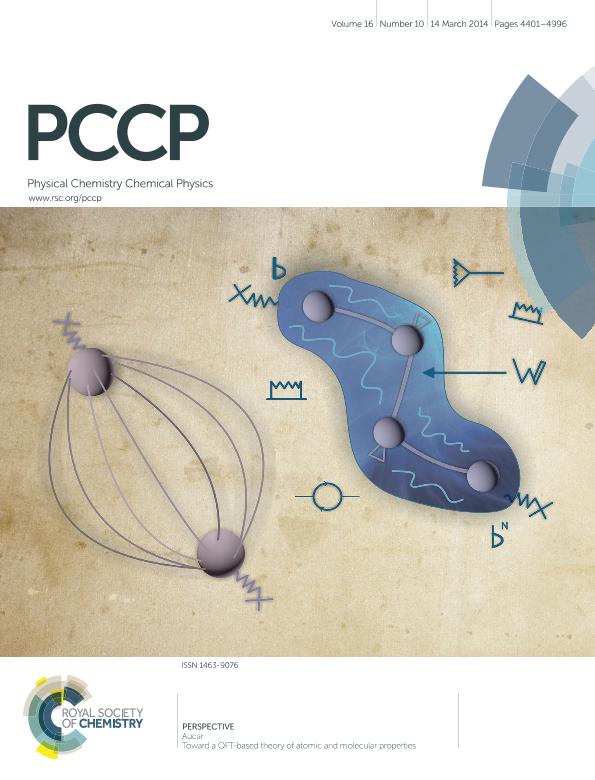Mostrar el registro sencillo del ítem
dc.contributor.author
Aucar, Gustavo Adolfo

dc.date.available
2016-12-27T21:19:48Z
dc.date.issued
2014-03
dc.identifier.citation
Aucar, Gustavo Adolfo; Toward a QFT-based theory of atomic and molecular properties; Royal Society Of Chemistry; Physical Chemistry Chemical Physics; 16; 3-2014; 4420-4438
dc.identifier.issn
1463-9076
dc.identifier.uri
http://hdl.handle.net/11336/10374
dc.description.abstract
The search of a QED-based (and then QFT-based) formalism that brings solid grounds to the whole area of relativistic quantum chemistry was just implicit in the first decades of the quantum theory. During the last few years it was shown that it is still unclear how to derive a well-defined N-electron relativistic Hamiltonian, and also the way negative-energy states may contribute to the electron correlation. Furthermore the relationship among electron correlation and radiative QED corrections is even more difficult to guess. They are few of the fundamental problems that need to be solved before such a program of research be finished within the wavefunction approach to the quantum physics. The polarization propagator formalism was developed as an alternative approach to study atomic and molecular properties within both regimes, relativistic and nonrelativistic. In this article we expose how far away one can go today working with polarization propagators, till including QED (and afterwards QFT) effects. We will uncover its deepest formal origin, the path integral formalism, which explains why polarization propagators can be written formally the same in both regimes. This will also explain why the NR limit is obtained scaling the velocity of light to infinity. We shall introduce few basic aspects of elementary propagators to show what they have in common with polarization propagators. Then we shall remark the most important news that appears with the last ones. Within the relativistic regime the contributions of negative energy orbitals to the electron correlation are straightforwardly included. New insights on the relationship between spin and time-reversal operators are also given, together with an ansatz on how to consider both, QED and electron correlation effects on the same grounds. We focus here on the treatment of the NMR spectroscopic parameters within such a formalism, that is still not broadly used by the quantum chemistry community. Most of the other response properties can be treated in a similar manner.
dc.format
application/pdf
dc.language.iso
eng
dc.publisher
Royal Society Of Chemistry

dc.rights
info:eu-repo/semantics/openAccess
dc.rights.uri
https://creativecommons.org/licenses/by-nc-sa/2.5/ar/
dc.subject
Path Integral
dc.subject
Polarization Propagator
dc.subject
Qed
dc.subject.classification
Física Atómica, Molecular y Química

dc.subject.classification
Ciencias Físicas

dc.subject.classification
CIENCIAS NATURALES Y EXACTAS

dc.title
Toward a QFT-based theory of atomic and molecular properties
dc.type
info:eu-repo/semantics/article
dc.type
info:ar-repo/semantics/artículo
dc.type
info:eu-repo/semantics/publishedVersion
dc.date.updated
2016-12-26T18:45:31Z
dc.journal.volume
16
dc.journal.pagination
4420-4438
dc.journal.pais
Reino Unido

dc.journal.ciudad
Cambridge
dc.description.fil
Fil: Aucar, Gustavo Adolfo. Consejo Nacional de Investigaciones Científicas y Técnicas. Centro Científico Tecnológico Nordeste. Instituto de Modelado e Innovación Tecnológica; Argentina. Universidad Nacional del Nordeste. Facultad de Ciencias Exactas Naturales y Agrimensura; Argentina
dc.journal.title
Physical Chemistry Chemical Physics

dc.relation.alternativeid
info:eu-repo/semantics/altIdentifier/doi/http://dx.doi.org/10.1039/c3cp52685b
dc.relation.alternativeid
info:eu-repo/semantics/altIdentifier/url/http://pubs.rsc.org/en/Content/ArticleLanding/2014/CP/C3CP52685B#!divAbstract
Archivos asociados
